Where to dig in?
For healthy tomato plants, you’ll want the best fertilizer for tomatoes such as organic fertilizers with balanced NPK ratios that support each growth stage. Dr. Earth Organic Tomato Fertilizer offers a proven 9-3-7 ratio with beneficial soil microbes, while Neptune’s Harvest provides quick nutrient uptake through its OMRI-certified liquid formula.
You can enhance these with worm castings for steady nutrient release and improved soil structure, or create homemade compost tea with molasses and crushed eggshells. Understanding proper timing and application methods will maximize your harvest potential.
Understanding NPK Ratios for Optimal Tomato Growth

Why do some tomato plants thrive while others struggle, even when grown in similar conditions? The answer often lies in understanding NPK ratios, which determine how well your plants access essential nutrients.
What NPK Components Do
Nitrogen (N) enhances leaf growth and development, creating the lush foliage your tomatoes need. Phosphorus (P) supports root development and flowering, building strong foundations for fruit production. Potassium (K) aids in disease resistance and fruit quality, protecting your plants while improving harvest outcomes. The use of organic fertilizers not only supports nutrient provision but also promotes soil health and sustainability.
Why Balance Matters
Proper NPK balance ensures your tomato plants receive the right nutrients at each growth stage for maximum productivity.
Different NPK ratios support different stages of plant development, so you’ll need to adjust fertilizer as your tomatoes grow. Balancing NPK is pivotal for optimal tomato growth, ensuring each nutrient works together effectively. Balanced nutrition is required throughout the growth stages, from germination to fruiting.
Top Organic Fertilizer Products for Tomato Plants

When you’re ready to give your tomato plants the best organic nutrition, choosing the right fertilizer product can make all the difference in your harvest quality and plant health. Several outstanding organic fertilizers deliver exceptional results for home gardeners.
Top organic fertilizer choices include:
- Jack’s Classic Tomato Feed – Proven effective in gardening tests for robust growth
- Dr. Earth Organic Tomato Fertilizer – Contains beneficial soil microbes with premium 9-3-7 NPK ratio
- Neptune’s Harvest Tomato & Vegetable Fertilizer – OMRI-certified liquid formula for quick uptake
- Gardener’s Supply Company Organic Tomato Fertilizer – Versatile option for containers, ground, or raised beds
These products offer reliable nutrition while supporting long-term soil health. You’ll find both granular and liquid options available, allowing you to choose based on your gardening preferences and application methods. Incorporating organic amendments like worm castings can help optimize drainage and improve root health in your container gardens. Remember that soil testing is the most important step before adding any fertilizer to prevent nutrient imbalances that could harm your plants.
Benefits of Worm Castings and Bat Guano for Tomatoes
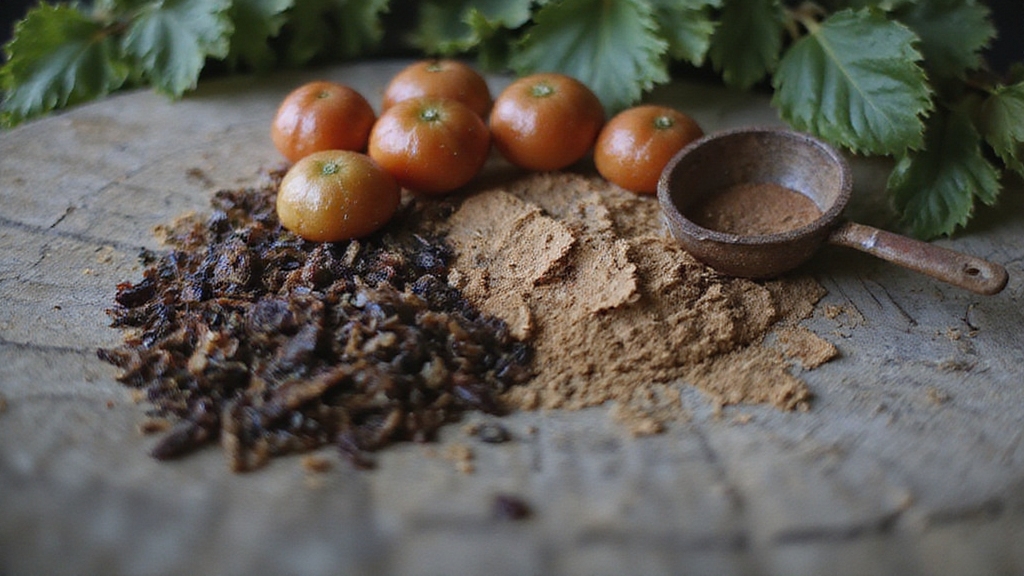
Two exceptional organic fertilizers can transform your tomato garden into a thriving, productive space that delivers outstanding harvests year after year. Worm castings and bat guano offer distinct advantages that complement each other perfectly for tomato cultivation. Trustworthy sources like High Mowing Organic Seeds often provide expert guidance alongside their offerings, ensuring you make the most of these fertilizers.
| Feature | Worm Castings | Bat Guano |
|---|---|---|
| Nutrient Release | Slow, steady supply | Quick absorption |
| Primary Benefits | Soil structure, microbial health | Flowering, fruit development |
| Application Safety | No burn risk | Safe when used properly |
| Soil Improvement | Enhanced water retention | Better texture over time |
| Best Usage | Season-long foundation | Growth stage boosts |
You’ll find worm castings create healthier soil biology, supporting disease resistance and stronger root systems. Bat guano’s high phosphorus content encourages abundant blooms and fruit set. Many successful gardeners who sell plant starts at farmers markets rely on worm castings to produce bigger, stronger seedlings that command premium prices. Both fertilizers work together to eliminate chemical stress while promoting sustainable growing practices.
Creating Homemade Compost Tea and Natural Fertilizers
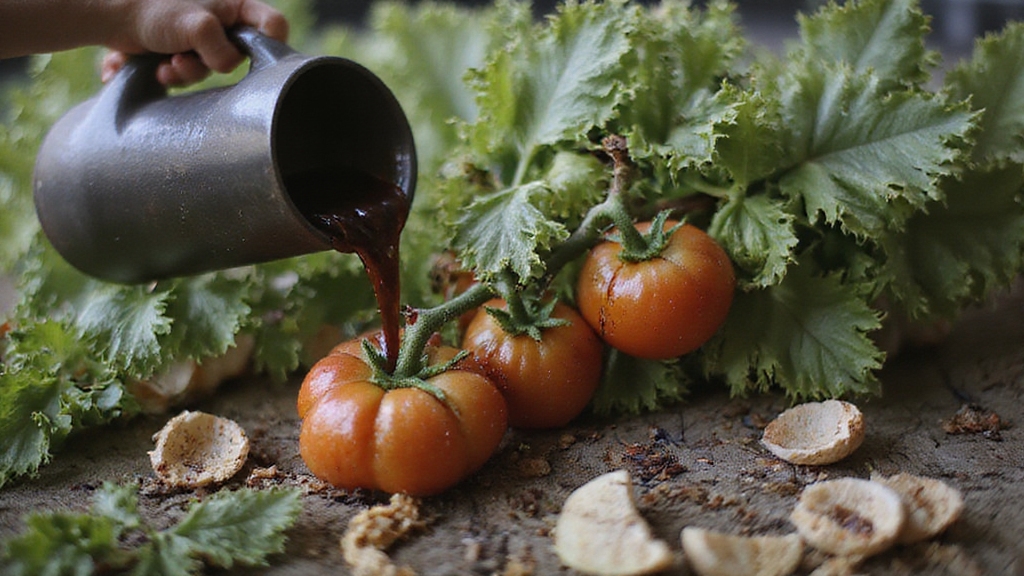
Three simple ingredients found in most homes can create powerful, nutrient-rich fertilizers that’ll boost your tomato plants’ health and productivity greatly. You can easily make compost tea by steeping quality compost in water for one week, stirring daily. This process releases beneficial microorganisms that improve soil health and suppress harmful pathogens. The Epica Countertop Compost Bin is an excellent choice for collecting and managing your compost efficiently, due to its stainless steel construction and odor-blocking filters.
For faster results, try aerated compost tea using an aquarium pump. The continuous bubbling reduces brewing time to just 48 hours while maximizing microbial activity. Equipment used for brewing must be thoroughly cleaned and disinfected after each batch to prevent contamination.
- Add molasses – feeds beneficial microbes during brewing process
- Include crushed eggshells – prevents blossom end rot with calcium
- Mix in rabbit manure – boosts nitrogen content naturally
- Apply morning spray – delivers nutrients while reducing disease risk
Use your homemade fertilizer every two weeks as a soil drench or foliar spray.
Proper Application Timing and Frequency Guidelines
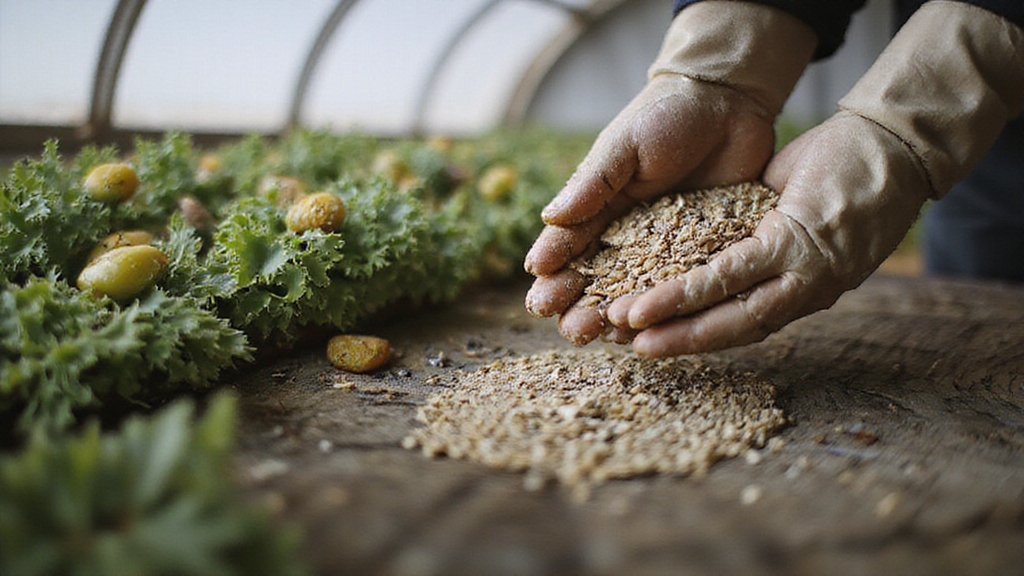
Although timing your fertilizer applications correctly can make the difference between mediocre and exceptional tomato harvests, many gardeners struggle with knowing exactly when and how often to feed their plants.
Early Growth Phase
Start fertilizing when your seedlings develop two sets of true leaves. Apply diluted, balanced fertilizer during regular watering sessions to prevent root burn. Loamy soil is ideal for growing tomatoes as it provides excellent drainage and moisture retention, supporting healthy root development.
Pre-Transplant and Flowering
Add nitrogen-rich fertilizers before transplanting to support stem development. Switch to phosphorus-rich formulations two weeks before flowering begins.
Fruit Development
Apply balanced fertilizers when fruits are small and developing. Continue with nitrogen and potassium as needed throughout the growing season. Stop fertilizing towards the end of the season to allow plants to focus energy on ripening existing fruit.
Best Practices
Fertilize after watering or rainfall to maximize nutrient absorption. Apply treatments in the evening to avoid sun damage to leaves.
Organic Vs Synthetic Fertilizers: Making the Right Choice
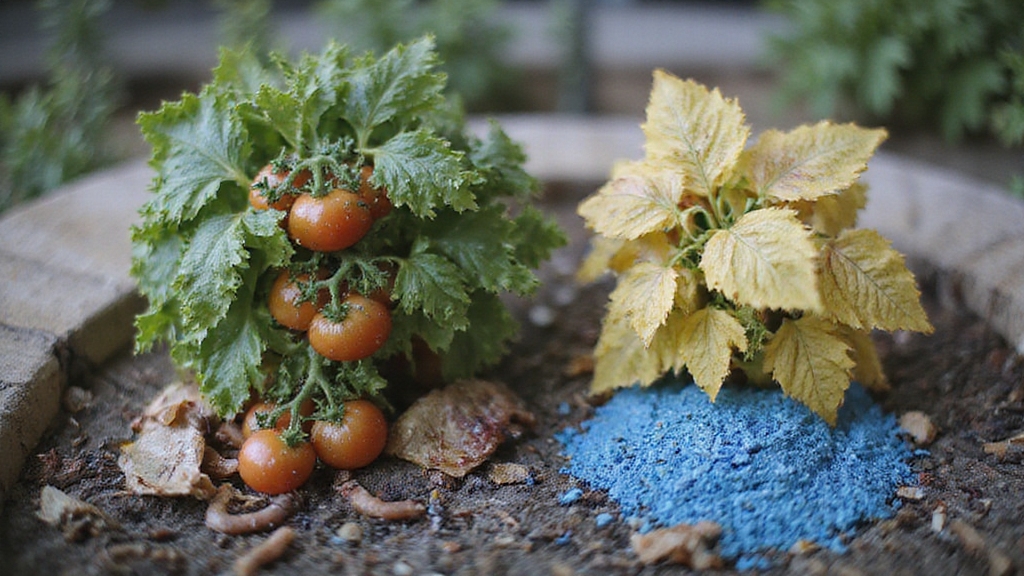
When choosing between organic and synthetic fertilizers for your tomato garden, you’ll face a decision that affects not only your plants’ growth but also your soil’s long-term health, your wallet, and the environment.
Organic fertilizers cost more upfront at $5-15 per pound compared to synthetic’s $2-7 per pound, but they require fewer applications throughout the season. They release nutrients slowly through microbial decomposition, creating sustained feeding over weeks or months. This prevents nutrient runoff and builds soil health naturally. Additionally, using strategies such as horticultural vinegar in tandem with organic fertilizers can enhance organic gardening efforts by providing weed control without harsh chemicals.
Synthetic fertilizers provide immediate results, showing visible growth within days. However, they may require more frequent applications and can contribute to environmental degradation. Repeated synthetic applications can disrupt soil biology and contribute to acidification over time.
Consider these key factors when deciding:
- Yield potential: Organic achieves 98.4% of synthetic yields
- Flavor enhancement: Organic often produces better-tasting tomatoes
- Environmental impact: Organic supports sustainable growing practices
- Long-term costs: Organic’s fewer applications offset higher initial prices
Essential Nutrients: Calcium, Magnesium, and Soil Health
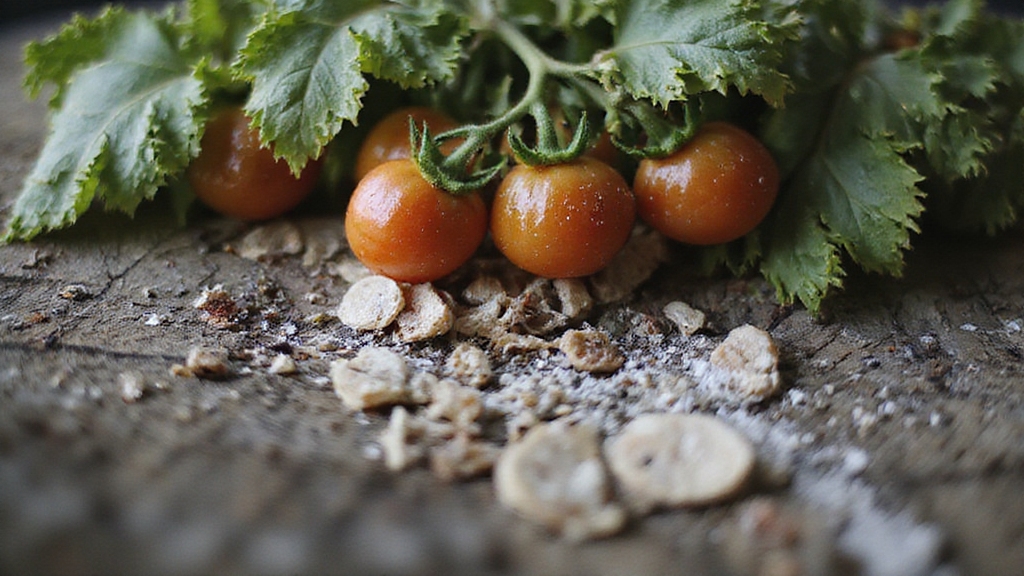
Beyond choosing the right fertilizer type, your tomatoes need specific secondary nutrients to thrive and produce healthy fruit.
Calcium: Your Defense Against Blossom End Rot
You’ll need approximately 152 pounds of calcium per acre to prevent blossom end rot, a common tomato problem. Calcium strengthens cell walls and maintains fruit quality. Add eggshells, dolomitic limestone, or calcium nitrate to your soil as reliable calcium sources. Consider utilizing ergonomic tools, like gardening stools for seniors, to make the application of supplements more manageable and reduce the risk of injury.
Magnesium: The Photosynthesis Powerhouse
Your plants require 5-25 pounds of magnesium per acre for efficient photosynthesis and energy production. Epsom salts or magnesium sulfate work well as magnesium supplements. Watch for intervein chlorosis—yellowing leaves with green veins—which signals magnesium deficiency.
Maintaining Soil Balance
Keep your soil pH between 6.0-6.8 for ideal nutrient availability. Test your soil regularly, since calcium, magnesium, and potassium compete for plant uptake. Balance these nutrients carefully for maximum tomato success. Large fruited varieties like beefsteak tomatoes particularly benefit from calcium supplementation when flowering begins.
Frequently Asked Questions
Can I Use Coffee Grounds as Fertilizer for My Tomato Plants?
You can use coffee grounds as fertilizer for your tomatoes, but they work best when composted first. Coffee grounds contain nitrogen, phosphorus, and beneficial micronutrients that support plant growth.
However, they don’t provide complete nutrition your tomatoes need. Add them to your compost pile, limiting them to 20% of total volume, then combine with balanced fertilizers for ideal results.
How Do I Know if My Tomato Plants Are Over-Fertilized?
You’ll notice several warning signs if your tomato plants are over-fertilized. Look for yellowing lower leaves, wilting despite adequate water, and brown leaf tips. Your plants may show lush green growth but won’t produce flowers or fruit.
Check for premature leaf drop, purple leaf undersides, and slow overall growth. You might also see black, rotting roots and salt crust forming on your soil’s surface.
What’s the Best Fertilizer for Tomatoes Grown in Containers Versus Ground?
You’ll need different approaches for each growing method. Container tomatoes require more frequent feeding, about every two weeks, because nutrients wash out faster from limited soil. Use liquid fertilizers like fish emulsion or formulated tomato blends.
Ground-grown tomatoes need less frequent applications, just 2-3 times per season, since they access more soil nutrients naturally through their expanded root systems.
Should I Fertilize Tomato Seedlings Differently Than Mature Plants?
You should absolutely fertilize tomato seedlings differently than mature plants. Start feeding seedlings only after they’ve developed two sets of true leaves, using half-strength liquid fertilizer with balanced NPK ratios like 10-10-10.
Mature plants need stronger concentrations and varying ratios depending on their growth stage. During flowering, increase phosphorus content, while fruiting plants benefit from potassium-rich formulas for better fruit quality.
Can I Mix Different Organic Fertilizers Together for Tomatoes?
You can definitely mix different organic fertilizers together for your tomatoes. Combining compost, manure, kelp meal, and worm castings creates a balanced nutrient profile that supports healthy growth.
Test your soil first to identify specific deficiencies, then blend materials accordingly. This approach provides better nutrition than single fertilizers, improves soil health, and often costs less than commercial options.
Conclusion
You’ve got the knowledge to grow amazing tomatoes with the right fertilizer choices. Remember to start with soil testing, choose balanced NPK ratios, and apply organic options at proper intervals. Whether you pick commercial products, make homemade compost tea, or use worm castings, consistency matters most. Monitor your plants’ response, adjust feeding schedules as needed, and you’ll enjoy healthier soil and more productive harvests.

